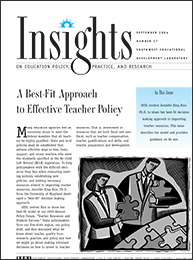At a Glance
Ensuring that all teachers are highly qualified means establishing effective teacher resource policies to hire, train, support, and retain teachers. Jennifer King Rice, Ph.D. from the University of Maryland has developed a "best-fit" approach to improving teacher resources. Her model is a multi-step decision framework to guide policymakers as they consider alternative investments in teacher policy. This issue of Insights describes Rice's best-fit approach and provides guidance on its use.
Research tells us that certain teacher characteristics are important in particular settings, for specific grade levels, and with select subgroups of students, making teacher quality far more complex and difficult to assess than just having a checklist of credentials to use in making decisions. There is no single strategy to deal with teacher quality under all circumstances. Therefore, it is most important to find a package of policies most appropriate for your context. The three basic steps to apply the best-fit model to develop this policy package are:
- Identify the teacher resource problem using adequate data
- Explore available policy alternatives to address the multiple dimensions of the problem
- Evaluate the cost-effectiveness of alternative sets of policies
Identify the problem
Ask some preliminary questions such as:
- What will it take to comply with teacher quality laws, regulations, or requirements?
- Is the teacher resource problem in particular areas, for particular students, or at particular times?
- Is the problem immediate or long-term, onetime or on-going?
- What do current teacher policies assume about teacher quality and is this supported by data?
- Do we have teacher resource data available to us now? If not, how would we get it?
- Who (e.g., teachers, students, administrators, parents, the community) does this problem affect? And, how does it affect them?
Explore policy alternatives
Review current and previous state and local policies and policy strategies being used in practice. Then develop a package of strategies that align with the problem, recognizing policies can often be more effective in combination than as individual stand-alone policies. Pay attention to the ways various policies interact; are they really complementary or do they compete with one another?
Evaluate policy cost-effectiveness
Ask these guiding questions:
- Do I have information about the costs and effectiveness of policy options?
- Are all costs considered? (e.g., hidden costs, short- versus long-term costs)
- How do these policies affect the expenditures in other budget areas?
- Could policies be put together in ways that make them more effective and/or less costly?
- How could the state finance the new policy package?
Putting the Best-Fit Approach to Use
Take the time to follow the necessary steps. Establish more comprehensive and useful data collection systems and conduct regular evaluations of policy cost-effectiveness. Seek out research-based information; federal, state, and local data; national and local experts in the field (especially school personnel); and technical assistance providers to help find answers that can guide effective teacher policy decision making. Be sure to make substantial and targeted investments in both teacher quality and education research to achieve the ultimate goal: student success.
Next Page: References

